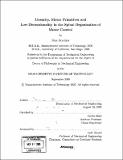Linearity, motor primitives and low-dimensionality in the spinal organization of motor control
Author(s)
Berniker, Max (Max Sam), 1971-
DownloadFull printable version (37.75Mb)
Other Contributors
Massachusetts Institute of Technology. Dept. of Mechanical Engineering.
Advisor
Emilio Bizzi.
Terms of use
Metadata
Show full item recordAbstract
The typical biological system is nonlinear, high-dimensional and highly redundant, all of which are burdens on controller design. Yet despite these complications, the central nervous system is able to control motor systems with an impressive level of complexity and effectivity. One such example is the frog. Evidence suggests that in frogs, the central nervous system, and the spinal cord in particular, may adopt simplifying strategies to ease the motor control problem. For instance, despite the known nonlinear nature of muscle, it has been demonstrated experimentally that spinally induced force production in the frog limb is linear in stimulation. Spinally encoded force fields have also been implicated as building blocks for generating hind limb movements. Furthermore, muscle EMG measurements for both intact and spinalized animals, have been shown to be low-dimensional; these measurements can be reconstructed as linear combinations of fixed muscle activations, or synergies. The evidence above suggests that the central nervous system may adopt simplifying strategies for the motor control problem. First, the thesis addresses the issue of linearity in isometric force fields. It proposes that this behavior can be explained as a result of biomechanical properties. To this end, a physiologically realistic model of the frog hind limb is analyzed. (cont.) The results suggest that, due to features of the musculo-skeletal structure, forces produced by the hind limb muscles are linear in activation, in large part and within the limb's workspace. The results, therefore, support our hypothesis that muscle forces which scale linearly in activation are a natural biomechanical result. The second portion of the thesis centers on the evidence of low-dimensional motor commands and the hypothesized motor primitives (in the form both of force fields and of muscle synergies). Many investigations have examined muscle synergies, probed motor behaviors for modular features in the form of force fields, and looked for connections between synergies and force fields. However, this work has largely been descriptive in nature, trying to explain the data without reference to the underlying control structure. We offer a principled explanation for motor primitives, for how force fields and synergies arise, and for how they are implicated in the organization of motor control. A controller that utilizes a reduced order model is proposed. Using apparatuses drawn from model order reduction theory, a method for finding a low-dimensional model that estimates a nonlinear model of the frog hind limb is examined. A formalism for defining motor primitives is proposed and the resulting primitives are compared with experimentally derived synergies. (cont.) The motor primitives are found to correspond well with several synergies, and to offer practical interpretations in terms of limb biomechanics. The reduced model is shown to be capable of generating natural motor behaviors as well as optimal control solutions. The evidence suggests that frog hind limb motor behaviors, and the spinal circuitry that coordinates these behaviors, are consistent with a control architecture that utilizes a reduced order model of the musculo-skeletal system in an effort to simplify motor control.
Description
Thesis (Ph. D.)--Massachusetts Institute of Technology, Dept. of Mechanical Engineering, 2005. Includes bibliographical references (p. 149-154).
Date issued
2005Department
Massachusetts Institute of Technology. Department of Mechanical EngineeringPublisher
Massachusetts Institute of Technology
Keywords
Mechanical Engineering.